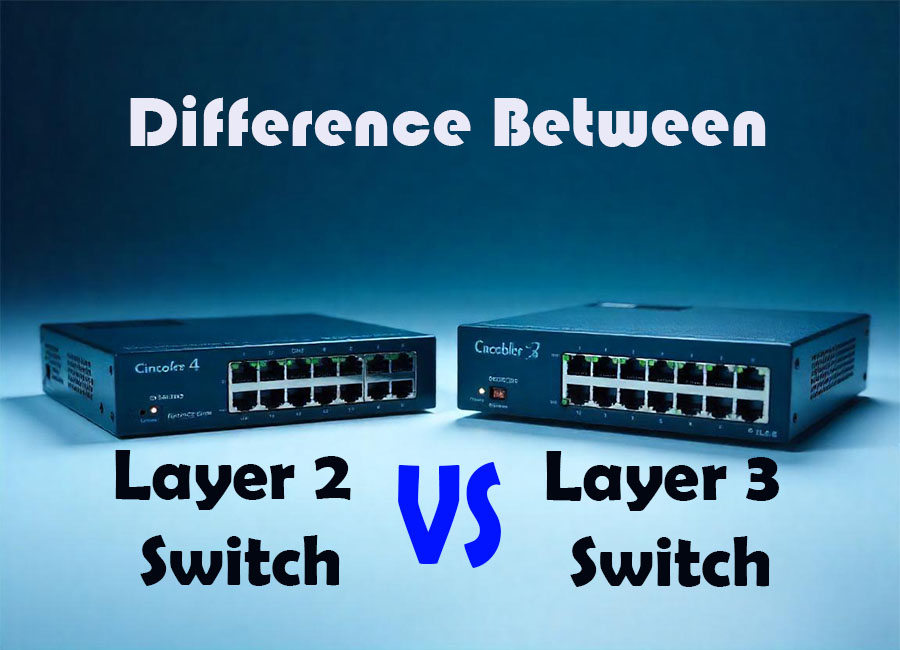
Switches are critical networking devices in any IT infrastructure, ensuring smooth and efficient communication between devices. In the realm of switches, Layer 2 and Layer 3 switches are commonly used, each serving distinct purposes based on the requirements of the network. While both devices share similarities with routers, they have different functionalities and capabilities. Let’s dive into what makes Layer 2 and Layer 3 switches different.
Layer 2 Switch: The Basics
A Layer 2 switch operates at the data link layer (Layer 2) of the OSI (Open Systems Interconnection) model. Its primary function is to forward traffic within a local network based on MAC (Media Access Control) addresses. Here’s how it works:
- MAC Address Forwarding: A Layer 2 switch examines the source and destination MAC addresses in the Ethernet frame and forwards the packet to the appropriate port.
- Switching Table: It builds a switching table (or MAC address table) by learning which MAC address is associated with which switch port.
- Broadcast Domains: Layer 2 switches do not break up broadcast domains, meaning that a broadcast sent by one device will be forwarded to all devices in the same network or VLAN.
- VLAN Support: Layer 2 switches support Virtual Local Area Networks (VLANs), which logically segment the network into different broadcast domains even if they are physically connected.
Key Features of Layer 2 Switch:
- Operates only within the local network (LAN).
- Does not route traffic between different networks or subnets.
- Uses MAC addresses to forward frames.
- Faster in local data switching as it doesn’t deal with IP addresses.
Layer 3 Switch: The Next Level
A Layer 3 switch, as the name suggests, operates at the network layer (Layer 3) of the OSI model, which is the same layer as routers. This switch can perform the same functions as a Layer 2 switch but with additional routing capabilities. It can forward data not only based on MAC addresses but also on IP addresses, making it more versatile.
- IP Routing: Layer 3 switches have routing capabilities and can route traffic between different VLANs or subnets. This process is called inter-VLAN routing.
- Routing Table: Like routers, Layer 3 switches maintain a routing table to determine the best path for forwarding packets between different networks.
- Routing Protocols: Some Layer 3 switches support routing protocols like OSPF (Open Shortest Path First), RIP (Routing Information Protocol), or EIGRP (Enhanced Interior Gateway Routing Protocol) to determine optimal paths for data transmission.
- Breaking Broadcast Domains: Unlike Layer 2 switches, Layer 3 switches can segment a network into different broadcast domains. Each VLAN or subnet can have its own broadcast domain.
Key Features of Layer 3 Switch:
- Can route traffic between different networks or subnets.
- Uses both MAC and IP addresses for forwarding.
- Supports routing protocols for dynamic routing.
- Breaks up broadcast domains, making the network more efficient by limiting the spread of broadcast traffic.
Key Differences Between Layer 2 and Layer 3 Switches
| Feature | Layer 2 Switch | Layer 3 Switch |
|---|---|---|
| OSI Layer | Data Link Layer (Layer 2) | Network Layer (Layer 3) |
| Forwarding Based On | MAC addresses | IP and MAC addresses |
| Routing Capabilities | No routing between subnets or VLANs | Routes traffic between different subnets/VLANs |
| Broadcast Domain | Single broadcast domain per VLAN | Breaks up broadcast domains |
| Switching Table | MAC address table | MAC address table + Routing table |
| Routing Protocol Support | Not supported | Supports routing protocols like OSPF, RIP, etc. |
| Primary Usage | LAN switching within a single network | Inter-VLAN routing and LAN switching |
Layer 2 and Layer 3 switches serve different roles in a network. Layer 2 switches are designed for fast, efficient local network communication using MAC addresses, while Layer 3 switches offer more advanced features, such as routing between subnets and VLANs, making them more versatile in larger networks.





